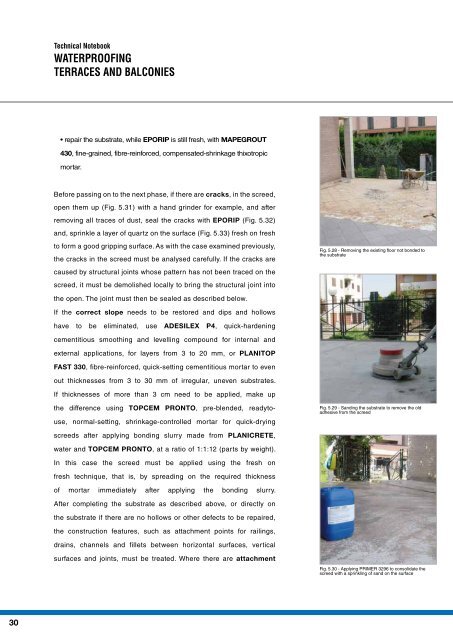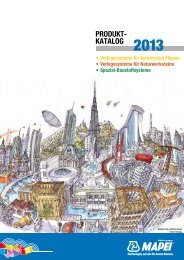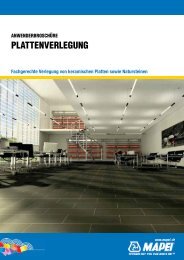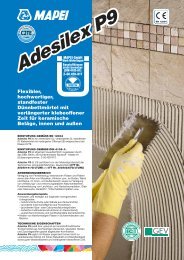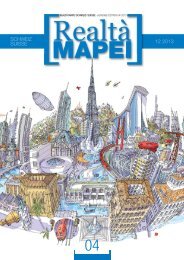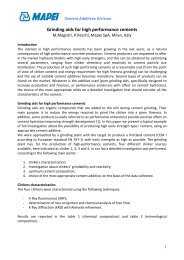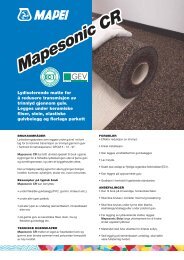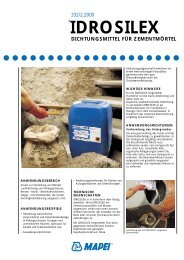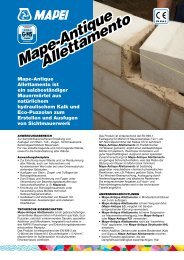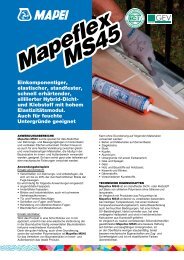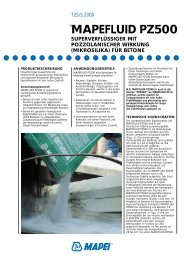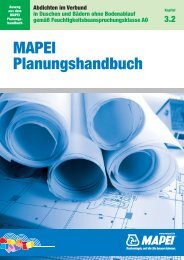WATERPROOFING TERRACES AND BALCONIES - Mapei
WATERPROOFING TERRACES AND BALCONIES - Mapei
WATERPROOFING TERRACES AND BALCONIES - Mapei
You also want an ePaper? Increase the reach of your titles
YUMPU automatically turns print PDFs into web optimized ePapers that Google loves.
30<br />
Technical Notebook<br />
<strong>WATERPROOFING</strong><br />
<strong>TERRACES</strong> <strong>AND</strong> <strong>BALCONIES</strong><br />
• repair the substrate, while EPORIP is still fresh, with MAPEGROUT<br />
430, fine-grained, fibre-reinforced, compensated-shrinkage thixotropic<br />
mortar.<br />
Before passing on to the next phase, if there are cracks, in the screed,<br />
open them up (Fig. 5.31) with a hand grinder for example, and after<br />
removing all traces of dust, seal the cracks with EPORIP (Fig. 5.32)<br />
and, sprinkle a layer of quartz on the surface (Fig. 5.33) fresh on fresh<br />
to form a good gripping surface. As with the case examined previously,<br />
the cracks in the screed must be analysed carefully. If the cracks are<br />
caused by structural joints whose pattern has not been traced on the<br />
screed, it must be demolished locally to bring the structural joint into<br />
the open. The joint must then be sealed as described below.<br />
If the correct slope needs to be restored and dips and hollows<br />
have to be eliminated, use ADESILEx P4, quick-hardening<br />
cementitious smoothing and levelling compound for internal and<br />
external applications, for layers from 3 to 20 mm, or PLANITOP<br />
FAST 330, fibre-reinforced, quick-setting cementitious mortar to even<br />
out thicknesses from 3 to 30 mm of irregular, uneven substrates.<br />
If thicknesses of more than 3 cm need to be applied, make up<br />
the difference using TOPCEM PRONTO, pre-blended, readyto-<br />
use, normal-setting, shrinkage-controlled mortar for quick-drying<br />
screeds after applying bonding slurry made from PLANICRETE,<br />
water and TOPCEM PRONTO, at a ratio of 1:1:12 (parts by weight).<br />
In this case the screed must be applied using the fresh on<br />
fresh technique, that is, by spreading on the required thickness<br />
of mortar immediately after applying the bonding slurry.<br />
After completing the substrate as described above, or directly on<br />
the substrate if there are no hollows or other defects to be repaired,<br />
the construction features, such as attachment points for railings,<br />
drains, channels and fillets between horizontal surfaces, vertical<br />
surfaces and joints, must be treated. Where there are attachment<br />
Fig. 5.28 - Removing the existing floor not bonded to<br />
the substrate<br />
Fig. 5.29 - Sanding the substrate to remove the old<br />
adhesive from the screed<br />
Fig. 5.30 - Applying PRIMER 3296 to consolidate the<br />
screed with a sprinkling of sand on the surface


